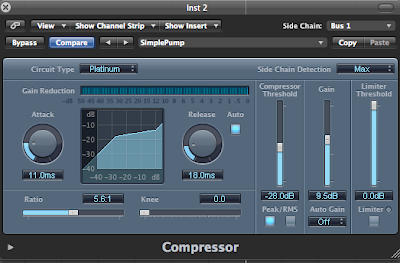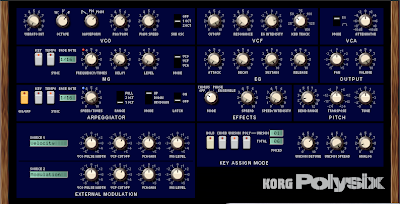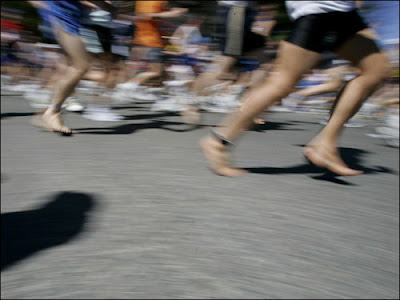
Side chain pumping isn't quite as ubiquitous as it was a few years ago, but it's still quite a common effect to hear in dance music and can be a lot of fun to mess around with. If you've never tried it before, today I'm going to show you how quickly and easy it can be done.
A side chain, quite simply, is an input into an effect (usually a compressor) that lets an outside signal modify the effects settings of another. Side chain pumping is basically the same thing as ducking. You know when you're listening to the radio and the DJ is talking over the intro of a song, and the volume of the music automatically goes down every time the DJ talks? That's ducking. The DJ's voice is being used to automatically control the level of the music. When you use a rhythmic signal to control the compression of another signal, you can get a very musical, pleasing pumping sound that can do everything from keeping the kick and bassline from interfering with one another, to adding a driving, pulsing feel to a musical part. As usual, I will be working in Logic, but it shouldn't be terribly hard to find a compressor plug-in with side chaining possibilities these days and the process is mostly the same regardless of DAW.
1. Open up Logic and create 2 new audio instrument tracks.
2. The first instrument is going to provide the signal that triggers the compressor. Although really any signal can be used here, the most common one to use is a 4-on-the-floor kick drum. I'm calling up Spectrasonics Stylus RMX and using the factory Massive Kick loop, but you can use any drum instrument that can provide a 4-on-the-floor kick. When you're done, check the LOOP box in the region's parameter controls in the top left hand corner of the arrange window so the 4-on-the-floor will last throughout the entire song.
3. We're just using this signal to control the compressor, though, we don't want to actually hear it. So, on the kick drum's instrument channel (on the mixer), you should see the output assignment right below the instrument's name. This probably reads OUT 1-2 right now, depending on how you have your system set-up. We don't want to hear it at all, so change this to NO OUTPUT.
4. While we're here, we want to route the silent kick drum signal to a bus, so that the compressor will be able to see it (at this time, Logic won't accept a direct output of an audio instrument as a side chain source). So go ahead and in the SENDS section above the instrument's name in the mixer, select BUS 1 and turn the send knob all the way up. However, since you have sent this signal to the bus, it is actually audibly playing back through that bus, which we don't want. So do the same thing you did to the instrument channel to the BUS 1 channel: change the output assignment of the bus to NO OUTPUT. Our kick is silent again, just how we want it.
5. On your second instrument slot, call up an instrument with some good pad or string sounds on it. Go ahead and record a short chord progression with it. Find a string or pad sound you like and on that instrument's mixer channel, assign a side chain-ready compressor to the INSERTS. I'm using Logic's built-in Compressor effect.
6. The first thing we need to do is route the kick to the side chain of this compressor. In Logic's Compressor, you'll find the Side Chain menu at the very upper right of the plug-in window. Click on the menu and it will list all available side chain sources. Look for BUS 1 and select it.
7. Now we need to tweak the Compressor's settings to optimize the pumping effect. Start out by setting your RATIO somewhere in the range of 4:1 to 6:1. There are no hard fast rules here, but that's a good area to start. Next, back off the compressor's attack time to at least 10ms or so. Your release time isn't quite as important, but if your compressor has an AUTO RELEASE time setting, as Logic's does, just select that. Otherwise, you want a low-medium setting for the release, say about 10-50 ms or so. If you set this too high, you will lose the pumping effect.
8. We're almost there, but we need to set the compressor's THRESHOLD level. This is the audio level at which the compressor is triggered, and in this case, basically controls how extreme a pumping effect we'll get. Go ahead and hit play on your sequencer so that pad part you programmed earlier plays back (you'll probably want to set it up to loop over and over). As it plays back, pull down the COMPRESSOR THRESHOLD slider until the GAIN REDUCTION meter is showing about a 20db reduction. If you've done things correctly, you should hear something like this:
You can obviously go a lot more subtle than this, and it is often appropriate to do so, in which case, you just need to mess around with your THRESHOLD setting. You may be asking why we bothered to jump through hoops to create a silent kick drum track versus just using the kick drum track from your song. The answer is, technically you can do exactly that. But because of the typical structure of dance music often involves breakdowns where the kick drum might drop out for a bit, creating a dedicated, silent kick specifically for side chaining means you can have that pumping effect all the time, even when the kick in your song drops out. As I always say, this is just to get you started. Experimentation is the key to finding just the right settings for your individual tastes!























































